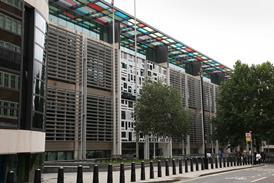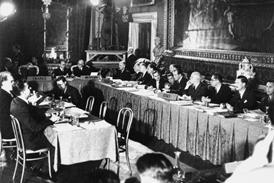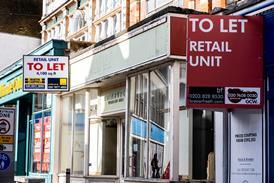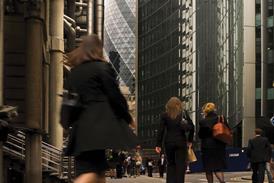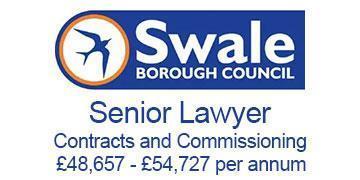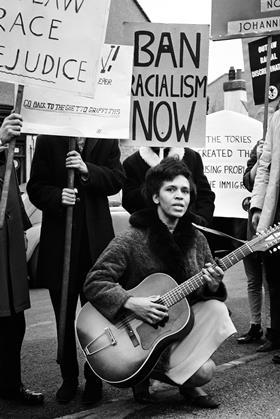
The Race Relations Act 1965 did not even cover Northern Ireland, because Wilson’s Labour government respected the Stormont parliament’s request for exemption. That was not the only concession during the legislation’s progress. Criminal offences became civil, and a plan for financial penalties for a breach was ditched. Acknowledged areas of racial discrimination, such as employment and housing, were not even addressed. And yet, the act is an important landmark. It established the principle that the law was the proper mechanism by which racial equality should be asserted. The three race relations acts that followed widened equality rights in scope and justiciability. But civil society must remain vigilant. As nativism rises across democracies, the legacy of the act and its successors appears to be in jeopardy.
Labour prime minister Harold Wilson was clear. He expected Conservative MP Peter Griffiths to be treated as a ‘parliamentary leper’. Griffiths had won the West Midlands Smethwick seat at the 1964 general election. Campaign material backing him included the slogan: ‘If you want a nxxxxr for a neighbour, vote Liberal or Labour.’
There is no record of Griffiths having personally delivered the line, but when challenged, he refused to disown it. He had won the seat from Labour’s shadow foreign secretary, against a national swing to Labour.
Parliament, public and the press in mid-1960s Britain was learning to talk about race in a post-imperial world. The impetus to do so was societal tensions linked to mass immigration from the ‘New Commonwealth’ that had begun in the late 1940s.
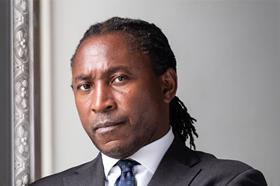
‘You have to understand the Britain of that time. This was a country still struggling with its colonial legacy,’ Garden Court Chambers’ professor Leslie Thomas KC says. ‘For centuries, Britain had prospered from the labour, land and resources of its colonies. Now, in the wake of a devastating world war, British subjects from the Caribbean, Africa, and South Asia were exercising their right to come to what many saw as the mother country.’
They had been invited to help rebuild, he points out: ‘This was the Windrush generation. They came as nurses, railway workers, engineers, cleaners and builders. They came to contribute. And instead of thanks, they were met with hostility.’
This was the Windrush generation. They came as nurses, railway workers, engineers, cleaners and builders. They came to contribute. And instead of thanks, they were met with hostility
Leslie Thomas KC
Actual numbers were a fraction of the total implied by openly racist public figures, such as British Union of Fascists leader Oswald Mosley, and sections of the press. In 1961, just 0.8% of the total population of the UK was a member of an ‘ethnic minority’.
But because they were concentrated in certain areas, not least because of racial discrimination by landlords elsewhere, such locations were targets for violent racist groups. In 1958 these attacks escalated into riots, notably at St Ann’s in Nottingham and in London’s Notting Hill.
Cordella Bart-Stewart, a solicitor and immigration judge who founded both the Black Solicitors Network (BSN) and the Association of Black Judges, notes: ‘Prejudice based on skin colour or religion was hostile and open towards people who were in fact mainly British citizens who happened to have been born in one the British colonies, most of which were still under British rule.’
‘Many white Britons viewed the arrival of Black and Brown people not as a return home, but as an invasion,’ Thomas says. ‘There were calls for repatriation. There were street attacks. There were signs in windows telling people they were not welcome. Racism was not a fringe issue. Generations of Black and Brown people lived with the humiliation of being openly rejected, degraded and excluded from daily life. This was not subtle. It was visible, legally permissible and emotionally scarring.’
Events also shone a light on race and policing. Caribbean governments made a joint protest to the UK government on prejudiced policing and the impact of poor housing on the emigrants.
At the same time, networks of anti-racism campaigners were forming, many increasingly effective. The 1963 Bristol Bus Boycott was one such manifestation – a successful campaign against the Bristol Omnibus Company’s policy, supported by the Transport and General Workers’ Union, of an employment colour bar.
Twin pressures
The Wilson government’s response to the domestic challenges of race relations reflected the twin pressures it faced.
Wilson’s home secretary, the barrister Sir Frank Soskice QC MP, set out the progressive intentions of the Race Relations Bill at second reading, appealing to parliament’s better nature: ‘It would be a tragedy of the first order if our country, with its unrivalled tradition of tolerance and fair play as between one man or woman and another, and perfect respect for the rights and personal worth and dignity of the individual, should see the beginnings of the development of a distinction between first- and second-class citizens and the disfigurement which can arise from inequality of treatment and incitement to feelings of hatred directed to the origins of particular citizens, something for which they are not responsible.
‘Our approach has two aspects. One is the exercise of an effective control on the numbers who come to our shores.’ (It is hard to read this as anything other than a concessionary nod to anti-immigration sentiment.)
The second aspect was the Race Relations Bill, which aimed at ‘achieving the task of settling the new arrivals into our community as in every sense first-class citizens’.
The impetus for the legislation was ‘public order’. This was threatened by ‘overt acts of discrimination in public places’, which were ‘intensely wounding to the feelings of those against whom these acts are practised, perhaps in the presence of many onlookers’, with the potential to ‘breed the ill will which, as the accumulative result of several such actions over a period, may disturb the peace’.
The targets for the legislation included ‘hotels, restaurants, cafes, public houses and other places where food and drink are supplied for consumption on the premises… theatres, cinemas, dance halls, sports grounds, swimming pools or other places of public entertainment or recreation, the test again being whether the place is open to the members of the public’.
Also, ‘transport services operating a regular schedule as distinct from on charter, and to all public premises, such as waiting rooms, used for the purposes of those services’, and any ‘museums, libraries and art galleries… municipal market places’ maintained by public bodies. Shops, clubs and private boarding houses were exempt.
This faced opposition. Peter Griffiths MP, clearly far from the ‘leper’ Wilson had hoped, said at its third reading: ‘The bill is in this sense an agitators’ charter for those bodies who want to find cases of discrimination in order to justify their existence, because if there is no racial discrimination we cannot have a committee against it.’ (Griffiths lost his parliamentary seat in the 1966 general election, but returned as MP for Portsmouth North in 1979, a seat he held till 1997.)
Publicans who objected to being caught by the legislation were singled out for support by Griffiths and others. The prospect of ‘time and money’ being spent dealing with complaints was raised. Many opposing voices focused on ‘unintended’ consequences of the legislation. The home secretary had opened his second reading speech with assurances that ‘free speech’ would be protected, seeking to head off another common criticism.
The Conservative opposition argued for a ‘conciliation’ mechanism to deal with breaches of the new law, but the government backed criminal sanctions. In the event, the government gave way. By the bill’s third reading, criminal law offences were confined to the most serious breaches of the law, notably ‘incitement to racial hatred’.
It became a civil offence to refuse to serve a person, to serve someone with unreasonable delay, or to overcharge, on the grounds of colour, race, or ethnic or national origins in the contexts set out in the act. Civil offence sanctions were limited to conciliation and securing an assurance not to return to the discriminatory behaviour. The Race Relations Board was established in 1966 to consider complaints under the act.
Soskice had acknowledged that racial discrimination was an issue in employment and housing, but these were kept out of scope of the legislation. At the request of the Northern Ireland government, the legislation would not apply there.
The Race Relations Act received royal assent on 8 November 1965 and came into effect a month later. Thomas says the act was a ‘modest and imperfect start to a journey that is still unfinished’.
Impact
At this distance, how should the significance of the 1965 act be judged? ‘It was more symbolic than enforceable, but it laid a legal and political foundation that could not be ignored,’ Thomas observes.
‘We often look to landmark legislation to map the history of social and cultural change,’ Bar Council chair Barbara Mills KC tells the Gazette. ‘The 1965 act is a key moment in the UK’s journey towards racial equality – a journey that remains ongoing.’
There were few criminal cases brought under the act, but those that were achieved a high profile. The first, in October 1967, was against a 17-year-old National Socialist Party member, found guilty at Middlesex Area Sessions of racial discrimination. The leader of the British National Socialist Movement, Colin Jordan, was jailed for 18 months in 1967.
Black immigrant activists were also charged. Black Power leader Michael Abdul Malik and several members of the Universal Coloured People’s Association went on trial accused of ‘stirring up hatred against white people’.
Overall, the act was considered to be ‘weak in terms of scope and enforceability’, Mills notes, but she argues that this does not detract from its significance: ‘The 1965 act signalled a new direction of travel in the law that was later bolstered by the race relations acts of 1968, 1976 and 2000.’
The Race Relations Act 1968 extended the remit of the 1965 act to cover employment and housing. Both were supplanted by the Race Relations Act 1976, which created the Commission for Racial Equality. The Race Relations Act 2000 applied the principles of the 1976 act to public bodies not previously covered, notably the police. Chief officers of police became vicariously liable for acts of racial discrimination by officers. This was repealed by the Equality Act 2010, which also replaced other discrimination legislation, most notably sex discrimination laws.
Like Mills, former Law Society president I. Stephanie Boyce also notes the foundational significance of the 1965 act, stressing that it was ‘the first enacted to address and eliminate racial discrimination in the UK’. As such, ‘it marked a vital shift in the prevailing winds of change: that equality and fairness must be matters of law as well as principle. It was a pivotal act in advancing equality, diversity, and inclusion’.
‘We have come far,’ Thomas says. ‘Britain today is almost unrecognisable from 1965. There is greater legal protection, greater representation, and greater awareness of systemic racism. But that does not mean the job is done.’
Boyce cautions: ‘The persistence of inequality, the rise of division, and the attempts to erode the rule of law remind us that progress cannot be taken for granted. It must be actively safeguarded and advanced if we are to build a society that truly reflects justice for all. We must stand firm in our shared values of justice, fairness and respect for the rule of law.
‘These are the foundations that hold us together as a society. This is the enduring legacy of the Race Relations Act.’
COMMONS DEBATE: MAKING THE CASE
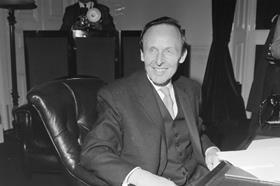
‘As has frequently been said, our approach has two aspects. One is the exercise of an effective control on the numbers who come to our shores… The other aspect of our policy is that directed to achieving the task of settling the new arrivals into our community as, in every sense, first-class citizens. It is to the achievement of this task that the bill is directed. Basically, the bill is concerned with public order. Overt acts of discrimination in public places, intensely wounding to the feelings of those against whom these acts are practised, perhaps in the presence of many onlookers, breed the ill will which, as the accumulative result of several such actions over a period, may disturb the peace.’
Second reading, 3 May 1965
‘The whole purpose of this bill, which I profoundly hope will be achieved, is to bring harmony, harmonious relationships, into our community, and not the reverse. It would be a major failure if the reverse ensued as the result of provisions of this bill. We have introduced it, as I have said on a number of occasions, because we are face to face with a new and major social problem—the presence with us of a very considerable number of settlers from Commonwealth countries. The primary purpose of this bill is to enable them to be settled happily into the community as fellow citizens and to prevent the kind of action which is wounding and provokes ill will and bad feeling. That is the object of this bill, and it has been designed for that purpose.’
Third reading, 16 July 1965
Professional focus
The legal profession has increasingly focused on its own record on race equality and other important forms of discrimination. ‘We still have a long way to go,’ Thomas notes. ‘Senior levels of the profession do not reflect the diversity of the society we serve. Discrimination persists. Sometimes it is overt. More often, it is structural or implicit.’
‘During my time as [Law Society] president, and since,’ says Boyce, who was the Society’s first Black president, ‘I have consistently championed greater representation within the legal profession and beyond, in the judiciary and in access to justice.’
‘There remain issues at the institutional level,’ Bart-Stewart says. ‘Some institutions or organisations have systems, structures or even expectations, that result in unequal treatment or discrimination whether conscious or not.’
Racial disparity and disadvantage persist in ‘education, healthcare, employment, policing and sentencing,’ she notes. ‘Lack of employment and inadequate or substandard housing, of course, leads to poorer outcomes regardless of ethnicity.’
In 1995, Bart-Stewart co-founded the BSN, launched ‘due to the proposed introduction of legal aid franchising’. She explains: ‘Most Black solicitors worked in small practices and faced an uncertain future. BSN articulated those concerns to decision-makers, which gave more time for all firms to prepare for implementation.’
Her focus is now also on the judiciary. ‘The number of Black judges in England and Wales has never exceeded 1.3% – around the same as the number of Black partners in the top 100 corporate firms,’ she says. In July, she founded the UK Association of Black Judges with the public support of Supreme Court justices.
Mills, the Bar Council’s first Black chair, is also focused on the profession’s record. ‘Our own Race at the Bar research reveals that Black women continue to have the lowest earnings among barristers and Black pupils are less likely to achieve tenancy than white pupils,’ she points out. ‘Our work on bullying and harassment consistently shows that people of colour are disproportionately affected, and this can lead to talented individuals leaving our profession.
‘We must work constantly and tirelessly to address these inequalities. I’m proud of the work that chambers, individuals and organisations employing barristers are doing in this space and the Bar Council will continue to champion equality, diversity and inclusion as part of its core work.’


